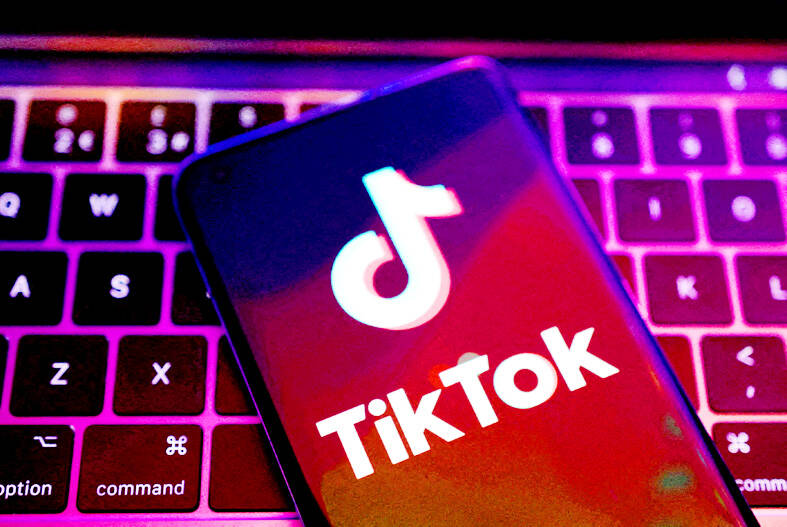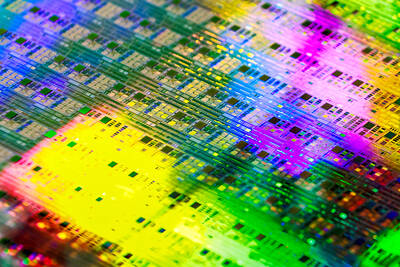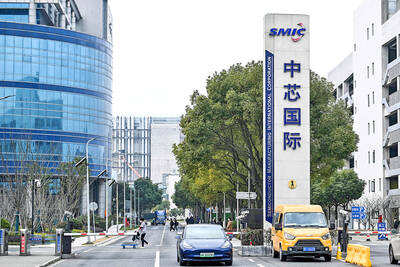TikTok abounds with viral videos accusing prestigious brands of secretly manufacturing luxury goods in China so they can be sold at cut prices.
However, while these “revelations” are spurious, behind them lurks a well-oiled machine for selling counterfeit goods that is making the most of the confusion surrounding trade tariffs.
Chinese content creators who portray themselves as workers or subcontractors in the luxury goods business claim that Beijing has lifted confidentiality clauses on local subcontractors as a way to respond to the huge hike in customs duties imposed on China by US President Donald Trump.

Photo: Reuters
They say this Chinese decision, of which Agence France-Presse has found no trace, authorizes them to reveal the hidden underbelly of luxury goods manufacturing in China.
They encourage Western consumers to buy directly from the Web sites selling these goods, which bear no logos or labels, but are said to be of the same quality and design as the expensive originals.
The prices are alluring, too, dropping from US$38,000 for a luxury bag to US$1,400.
Brands targeted — which include Hermes, Chanel and Louis Vuitton, whose goods are produced in Europe and the US according to their Web sites — declined to respond to questions about the claims made in the viral videos.
However, for Jacques Carles, head of the French Luxury and Design Centre, a management consultancy, the notion that luxury brands would manufacture goods in China is simply “absurd.”
“It would be suicidal. If there was evidence — and there isn’t — it would be the end. These brands aren’t stupid,” Carles told reporters.
While the TikTokers point to the skill of the Chinese workers, presented as the little hands behind the big luxury names, “these counterfeit workshops absolutely do not respect all the required stages in the manufacturing process,” he said.
Carles cited the example of Hermes’ Birkin bag, which requires “hundreds of hours of work” to produce.
He said that the Internet clip makers were, “by creating doubt,” actually looking to “open up an opportunity ... to shift their stocks” of counterfeit goods.
“It’s a viral campaign that’s spread on social networks [and] is difficult to counter,” he said.
Luxury brands chose to remain silent and “treat the phenomenon with scorn,” which was a mistake in his view, he added.
The accusation that luxury goods officially manufactured in Europe were in reality being secretly made in China “does not make any sense,” said Michel Phan, professor of luxury marketing at Emlyon Business School in France.
Phan rejected the argument made on TikTok that this was a Chinese retort to US trade tariffs.
“Hurting European luxury brands will not change anything [for] the US government because they are not related to those brands,” he said.
“All the videos online mentioning that luxury brands manufactured their products in China and then put the ‘Made in France’ label before selling them are nonsense,” he said. “It is illegal to do so and no brand will take the risk to get caught [sic] doing it.”
The e-commerce department at the Chinese Ministry of Commerce said in a statement that “any misleading marketing, infringement or counterfeit activities” by entities posing as subcontractors for established brands “will be promptly referred to law enforcement agencies for investigation and action.”
Comments on the viral clips, portrayed as coming from Internet users rather than the video creators themselves, seem to show that the message resonates.
“I’m so annoyed. I paid top price!” one said in a video comment.
“I’m such a sucker,” another said.
Some leave comments asking for the names of “suppliers of luxury goods” in China from whom they can buy the items cheaply.
Meanwhile, Chinese vendors are also selling counterfeit luxury goods directly on TikTok, with links to their Web sites. The TikTok live reels garner hundreds of views each.
They show row upon row of shelves full of luxury items, all numbered.
“DHL delivery. Products identical to those in stores. The only difference is the price,” says one, using an artificial intelligence-generated voice in French.
Internet users are invited to scan a QR code or click on a link to complete their purchase via WhatsApp or PayPal.
AFP has found a score of similar live feeds, released simultaneously in English and French, suggesting that the main targets are Internet users in Europe and the US.
China is regularly accused of being the world’s top producer of counterfeit goods.
Some estimates suggest that 70 to 80 percent of all fakes are manufactured there.
In EU states and a number of other countries there are hefty penalties for purchasing counterfeits.
In France, that could mean a three-year prison term and a fine of 300,000 euros (US$340,600).
Customs authorities might also confiscate counterfeit goods and fine the purchaser the equivalent of the items’ true value.
The EU Intellectual Property Office says that counterfeiting costs European industry 16 billion euros a year, with the clothes, cosmetics and toy sectors being the worst affected.

NO BREAKTHROUGH? More substantial ‘deliverables,’ such as tariff reductions, would likely be saved for a meeting between Trump and Xi later this year, a trade expert said China launched two probes targeting the US semiconductor sector on Saturday ahead of talks between the two nations in Spain this week on trade, national security and the ownership of social media platform TikTok. China’s Ministry of Commerce announced an anti-dumping investigation into certain analog integrated circuits (ICs) imported from the US. The investigation is to target some commodity interface ICs and gate driver ICs, which are commonly made by US companies such as Texas Instruments Inc and ON Semiconductor Corp. The ministry also announced an anti-discrimination probe into US measures against China’s chip sector. US measures such as export curbs and tariffs

The US on Friday penalized two Chinese firms that acquired US chipmaking equipment for China’s top chipmaker, Semiconductor Manufacturing International Corp (SMIC, 中芯國際), including them among 32 entities that were added to the US Department of Commerce’s restricted trade list, a US government posting showed. Twenty-three of the 32 are in China. GMC Semiconductor Technology (Wuxi) Co (吉姆西半導體科技) and Jicun Semiconductor Technology (Shanghai) Co (吉存半導體科技) were placed on the list, formally known as the Entity List, for acquiring equipment for SMIC Northern Integrated Circuit Manufacturing (Beijing) Corp (中芯北方積體電路) and Semiconductor Manufacturing International (Beijing) Corp (中芯北京), the US Federal Register posting said. The

READY TO HELP: Should TSMC require assistance, the government would fully cooperate in helping to speed up the establishment of the Chiayi plant, an official said Taiwan Semiconductor Manufacturing Co (TSMC, 台積電) yesterday said its investment plans in Taiwan are “unchanged” amid speculation that the chipmaker might have suspended construction work on its second chip packaging plant in Chiayi County and plans to move equipment arranged for the plant to the US. The Chinese-language Economic Daily News reported earlier yesterday that TSMC had halted the construction of the chip packaging plant, which was scheduled to be completed next year and begin mass production in 2028. TSMC did not directly address whether construction of the plant had halted, but said its investment plans in Taiwan remain “unchanged.” The chipmaker started

MORTGAGE WORRIES: About 34% of respondents to a survey said they would approach multiple lenders to pay for a home, while 29.2% said they would ask family for help New housing projects in Taiwan’s six special municipalities, as well as Hsinchu city and county, are projected to total NT$710.65 billion (US$23.61 billion) in the upcoming fall sales season, a record 30 percent decrease from a year earlier, as tighter mortgage rules prompt developers to pull back, property listing platform 591.com (591新建案) said yesterday. The number of projects has also fallen to 312, a more than 20 percent decrease year-on-year, underscoring weakening sentiment and momentum amid lingering policy and financing headwinds. New Taipei City and Taoyuan bucked the downturn in project value, while Taipei, Hsinchu city and county, Taichung, Tainan and Kaohsiung